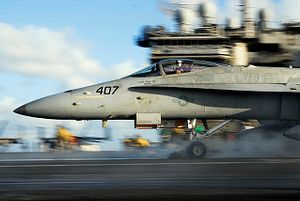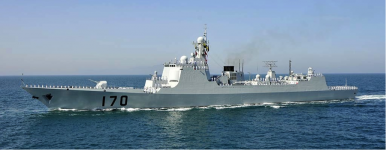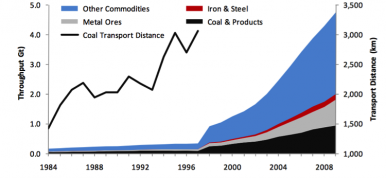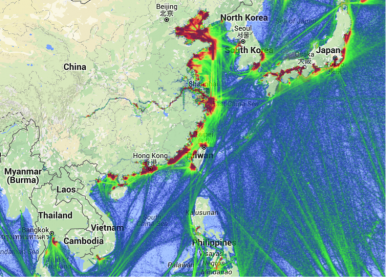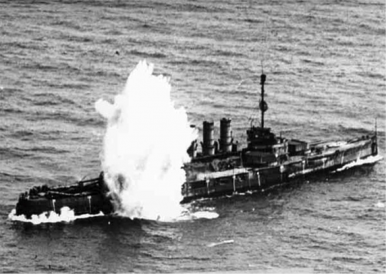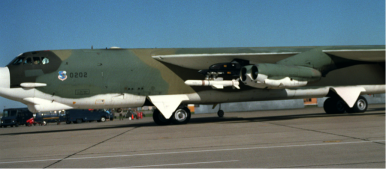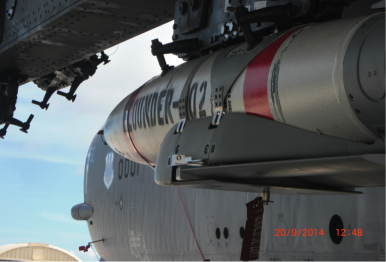The Maritime Domain is “all areas and things of, on, under, relating to, adjacent to, or bordering on a sea, ocean, or other navigable waterway, including all maritime-related activities, infrastructure, people, cargo, vessels, and other conveyances.”
In the past decade and a half, American airpower has been heavily involved in fighting irregular wars. Often unacknowledged even by Department of Defense leadership, the Air Force and Naval aviation have been continuously involved in combat operations starting with Desert Storm and continuing without a break since then. For almost a quarter century, there has not been a single day where traditional combat air forces (CAF) have not been involved in a combat operation. In that timeframe, the application of airpower has been very land-centric, against adversaries who have no significant seapower capabilities and no reliance on maritime transportation. Both the Air Force and Navy essentially ignored antisurface warfare capabilities to the point where no USAF aircraft or Navy submarine carries antiship cruise missiles. Aerial mining, while regularly practiced, has quite literally not evolved since Vietnam. The intense involvement on conflicts in the Balkans, Afghanistan and the Middle East has led to the neglect of the countermaritime capabilities that we will need to fight other adversaries.
In the meantime, both Russia and China have substantially improved their naval capabilities. While the Russian Navy is still a shadow if its former self, the People’s Liberation Army Navy (PLAN) has undergone over two decades of sustained modernization. The outcome of Russian system development and Chinese development of “counter-intervention” capabilities is that both navies have ships that are substantially more advanced, better defended, and pack a heavier punch than older ships. The PLAN has fielded capable surface combatants in significant numbers, operated them at long distances, and is taking the first steps towards the development of a blue-water capability. Clearly they have recognized what the U.S. has temporarily forgotten – that control of the maritime domain is not a luxury for a modernized nation with global interests. The maritime domain is indeed the “middle domain,” which can reach out to others and be reached by them. In the event that the U.S. has to fight China in the Indo-Pacific region, the former’s lack of air-delivered countermaritime capabilities will be a sore deficiency, not quickly remedied.
China as an Island
We don’t think of China as an island nation, but we should. China has long since expanded to its natural land borders, having reached only slightly beyond their modern limits during the Qing Dynasty (1644-1911). China’s land borders include the barely-inhabitable (the Gobi and Taklimakan deserts), the impassible (the Himalayas) and the inhospitable (jungles stretching from India through Vietnam). In China’s long history, there has been plenty of time to inculcate hostility among neighbors, and the current borders are liberally sprinkled with territorial disputes and ancient enemies. Bhutan hasn’t had formal diplomatic relations with China since 1960; China has occupied Bhutanese, Tibetan, Indian and Vietnamese territory in living memory, and has skirmished with the Russians. The land links crossing China’s borders are rudimentary and complicated by the fact that even the rail lines are incompatible with their neighbors – Russia and Central Asia use Russian-gauge rails and Vietnam uses French gauge. There is no alternative to sea travel for the import or export of goods, and waterway traffic is likewise irreplaceable. In the face of a maritime interdiction challenge, China has no other option for the transport of goods or energy normally moved by water.
Figure 1: PLAN Type 052C Guided Missile Destroyer Lanzhou
China is almost entirely dependent on maritime routes to move goods to and from the country. In a given year, 98 percent of all traffic (by volume) crossing China’s borders arrives or departs by sea. China is also highly reliant on riverine and coastal transport for the internal movement of goods, a dependency that started to explode in 1997. With the vast majority of goods traffic accomplished by water, China might as well be an island nation comprising more than one island. The comparison to Imperial Japan is obvious, and has warfighting implications. Imperial Japan then, like China today, required resources that came from far away, and those resources came by sea.
Figure 2: China’s Domestic Transportation via Major Coastal Ports, 1984-2009 (Carnegie Endowment)
China is well aware of its “Malacca Dilemma,” recognizing that the vast majority of its oil imports, and a great deal of other resources, have to pass through the Straits of Malacca. This fact of life is but one element of China’s maritime challenge – access to the Chinese coast from the ocean is dominated by island chains owned by nations that are not China. To make matters worse for China, many of those countries are U.S. allies. China is hemmed in by three U.S. treaty partners (Japan, Korea and the Philippines) and one country (Taiwan) with an enduring defense relationship with the U.S. While there is a great deal of writing in the Western press about the so-called “anti-access, area denial (A2AD) challenge posed by Chinese military forces, there is only a limited recognition that this challenge applies even more to the Chinese than it does to the U.S. and its allies. The U.S. has a very limited need to fight the close battle inside the first island chain, while the PRC has to get outside to survive. An improved and expanded countermaritime capability would greatly enhance warfighting capabilities against potential adversaries in the Pacific Rim by introducing a credible and effective method of countering an adversary’s ability to project power using maritime methods.
Figure 3: Commercial Maritime Traffic, 2013/14 (marinetraffic.com)
Airpower and the Maritime Domain
The introduction of aircraft into military service forever changed combat operations in the maritime domain. While roughly three quarters of the earth is covered by ocean, all of it is covered by air. Aircraft could survey large areas of ocean much faster than any ship, and deliver devastating attacks as well. Even before World War II, the Navy was well aware of the potential of carrier aviation to dominate the maritime environment. The Pacific war forever changed the nature of naval warfare as the carrier took the place of the battleship and the ancient “line of battle” disappeared. The biggest punch and longest reach of conventional naval power now rested with naval aviation.
Figure 4: SMS Ostfriesland under air attack. (National Archives)
The Pacific War against Japan was fought from a strategic position that is far inferior to the current U.S. position versus China. The U.S. position in the Pacific collapsed rapidly following the attack on Pearl Harbor; by December 10, 1941, not a single operational Allied capital ship floated between Africa and San Diego. Within three weeks, Guam and Wake had fallen and Japanese forces were poised on the outskirts of Manila. The Asiatic fleet was well into a retreat that would end in Australia. American’s possessions in the Pacific had been captured or isolated within days of the start of the war, and the Japanese advance would not be checked until the Battle of the Coral Sea in May 1942. The campaign to strangle Japan’s maritime transport began immediately, and unrestricted submarine warfare commenced before the formal declaration of war. The Far East Air Force had precious little with which to contain the Japanese advance, but what they had was devastatingly effective.
Airpower accounted for more Japanese warship tonnage sunk in the Pacific than any other source, with carrier and land-based air each accounting for more tonnage than surface ships. Land-based air was the major source of airpower in the west, and was utilized heavily in 1942 and 1943, while carrier-based air supported successive island-hopping campaigns beginning in November 1943. The range and striking power of 5th Air Force’s light bomber fleet allowed for wide ranging daytime attacks throughout the Solomons Islands. Combined with nighttime operations by PT boats and submarines, the maritime interdiction efforts caused the Japanese to terminate offensive operations in the Solomons by November 1942, and abandon New Guinea by May of 1943.
The Pacific War was largely fought over island real estate that could be used to support and operate ships and aircraft on the way to Japan, which was largely defeated through a maritime interdiction campaign punctuated by direct air attack on the home islands. Airpower was used to support an extensive interdiction campaign during the Korean War, air-laid mines closed off all shipping to Vietnam. In the Cold War, B-52s from Loring, Maine were a potent Harpoon-armed strike force intended to hammer Soviet task forces at extended range.
Figure 5: A SAC B-52G taxis for the first B-52 launch of an AGM-84A Harpoon (National Archives)
Naval aviation can reach deeper inland than it used to, further expanding the ability of the U.S. to project power from the sea. But with the shrinking of the U.S. Navy’s surface combatant fleet, Naval aviation’s presence likewise diminished. Today, carrier aviation provides a bubble of power projection capability centered on the carrier battlegroups. The USAF’s bomber force provides a long range, rapid-response antisurface warfare capability and is ideally suited to the Pacific, where the ranges are long, the ocean expanses massive, and the bases limited. In a theater so completely dominated by large expanses of open water, airpower holds the key to U.S. power projection.
Antisurface Warfare
More accurately, airpower would hold the key to U.S. power projection, if the U.S. had maintained its Cold War investment in it. As the B-52H was upgraded to handle more capable weapons, the Harpoon antiship missile was removed from its weapons library. The Navy did the same thing with its attack submarines, leaving the Harpoon solely the purview of naval aviation and surface combatants. At this time, the Air Force has no weapon capable of engaging a moving ship from outside visual range, excepting the AGM-88 HARM. Harpoon has not kept up with the times, and even an air-launched shot must be taken within the range of ship-based air defenses, a poor bet at the best of times. The Naval Strike Missile still awaits an air-launched upgrade, an extended range Harpoon sits in the shelf, and the long-range antiship missile (LRASM) program is purely developmental and expensive enough that procurement of sufficient numbers is in question.
Similarly, the Air Force has not invested in the sensors to reliably detect, identify and engage enemy surface ships from outside their anti-air warfare (AAW) range. While the Air Force has the aircraft with the long range needed to span the ocean from distant basing, that capability does not translate into a capability to find and kill ships. The B-52H, which assumed this role in the Cold War, is ripe for an upgrade that would increase its range, improve its sensors, and add a ship-killing punch. Similarly, the rest of the bomber force and medium-range fighters like the F-15E lack the sensor and weapons combination needed to detect, identify and strike maritime surface targets from a distance. Properly configured, individual flights of aircraft could reliably and precisely attack ships without the need to rely on a cumbersome, theater-wide reconnaissance and strike complex.
Recent advances in aerial mining could also lead to a responsive, standoff antiship mining capability, which can be used by any aircraft capable of employing JDAM. In September 2014, a B-52H dropped a Quickstrike-ER, the first-ever precision, standoff aerial mine. Prior to that demonstration, aerial minelaying was a hazardous, low-altitude mission requiring multiple passes and capable of laying minefields only in uncontested airspace. By adding wings and a guidance tailkit to off-the-shelf Quickstrike mines, precision minefields can be laid in a single pass from standoff distances. Useful against warships, the Quickstrike bottom mine is even more effective against the merchant hulls necessary for maritime transport.
Figure 6: Flounder 002, a GBU-62B(v)/B Quickstrike ER, loaded on a B-52H during VALIANT SHIELD 14 (Col Mike Pietrucha, USAF)
The United States could reassemble an unparalleled countermaritime capability with existing aircraft and weapons, with relatively minor system development efforts. Airpower capabilities allow for the ocean-spanning reach necessary to operate from distant bases over the long ranges typical of the Indian and Pacific oceans. The flexibility and rapid response capability of airpower is a key enabler for a strategic interdiction campaign, as well as providing a credible deterrent to nations contemplating offensive amphibious operations. With respect to China, the country is effectively an island nation hemmed in by unfavorable geography, but one that is extremely dangerous if approached closely. If it becomes necessary to fight China, the maritime domain is the key to a successful strategic campaign, and modern airpower is the key to the maritime domain.
Col. Mike “Starbaby” Pietrucha was an instructor electronic warfare officer in the F-4G Wild Weasel and the F-15E Strike Eagle, amassing 156 combat missions and taking part in 2.5 SAM kills over 10 combat deployments. As an irregular warfare operations officer, Colonel Pietrucha has two additional combat deployments in the company of U.S. Army infantry, combat engineer, and military police units in Iraq and Afghanistan. The views expressed are those of the author and do not necessarily reflect the official policy or position of the Department of the Air Force or the U.S. Government.













